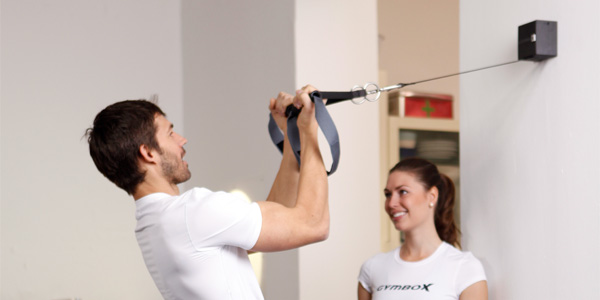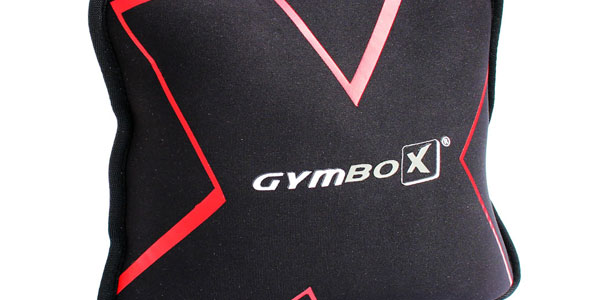Studien zum Sling Training
Wir stellen Ihnen aktuelle und ältere Studien zum Schlingentraining vor. Wer hätte gedacht, dass das Sling Training in der Forschung schon um die Jahrtausendwende aktuell war.
Klicken Sie auf den Titel der Studie um eine Zusammenfassung zu lesen.
2011 - Effects of Suspension Training on the Growth Hormone Axis (Dudgeon WD, Aartun JD, Thomas DD, Herrin J, Scheett TP)
Suspension training is a relatively new mode of exercise that uses the exercisers own body weight as resistance. Suspension training employs an assortment of upper and lower body exercises which all require the individual to maintain balance while performing the various exercises. PURPOSE: The purpose of this study was to determine the growth hormone axis responses to a single suspension training workout. METHODS: Twelve recreationally active (structured exercise at least 3 days/week) males (22.0 +/- 0.7 years, 176.7 +/- 2.3 cm, 79.4 +/- 3.0 kg, 13.6 +/- 1.3% body fat) completed two suspension training familiarization workouts prior to testing. For sample collection an IV catheter was placed in a forearm vein prior to a 60 minute suspension training interval workout that consisted of 23 exercises performed for 30 seconds each followed by 60 seconds of rest. Blood samples were collected pre, mid, post, 30 min, 60 min and 120 min post workout. Serum samples were analyzed in duplicate using commercially available ELISA kits. RESULTS: There was a 4.5-fold increase (p = 0.008) in growth hormone (GH) from pre to mid, a 6-fold increase in GH from pre to post (p = 0.006) and a trend for an increase in GH (p = 0.07) from pre to post 30. There was a trend for an increase in insulin-like growth factor (IGF)-I (p = 0.06) from pre to post 30 and a trend for an increase in IGFBP-3 (p = 0.07) from pre to mid. CONCLUSIONS: These data indicate that a suspension training workout using the recommended 30 sec:60 sec work:rest ratio is sufficient to stimulate the GH axis in recreationally active young adult males. Practical Applications: This evidence supports the use of suspension training as a stimulus for anabolic hormone release, suggesting this is a viable alternative to traditional resistance training for stimulating the anabolic hormones that support recovery and muscle growth. Acknowledgments: This work was funded by The Citadel Foundation and Fitness Anywhere, Inc. (C) 2011 National Strength and Conditioning Association.
2011 - Clinical study on effects of sling exercise therapy on periarthritis of shoulder (Wu Yulan, et al)
To explore the effects of sling exercise therapy on pain and motor function of scapulohumeral periarthritis.Methods:80 patients with scapulohumeral periarthritis were randomly divided into traditional physical therapy group(group A),received massage and medium frequency electrotherapy and sling exercise therapy group(group B).Two groups were assessed by visual analogue scale and the range of motion at beginning and 2 weeks later.Results:The assessments of group B were better than that of group A after 2 weeks‘ treatment.There was significant difference between the two groups(P0.05).Conclusion: Sling exercise therapy is more effective than traditional physical therapy on motor function and pain of periarthritis of shoulder.
2011 - The Effectiveness of Traditional and Sling Exercise Strength Training in Novice Women (Dannelly BD, Otey SC, Croy T, Harrison BC, Rynders C, Hertel J, Weltman AL)
Strength training often combines closed-kinetic-chain exercises (CKCEs) and open kinetic-chain exercises (OKCEs). The CKCE may be more effective for improving performance in lower-body training. Recently, we reported upper-body CKCE (using a commercially available system of ropes and slings) was as effective as OKCE training for strength gains and that CKCE was more effective than OKCE for improving throwing performance. To our knowledge the effectiveness of a strength training program that uses exclusively CKCE is unknown. In this study, we examined the effectiveness of CKCE vs. OKCE strength training programs in women enrolled in an introductory strength training program. Twenty-six participants were randomized to OKCE (traditional exercises) or CKCE (sling-based exercises). Participants completed 6 sets per week for 13 weeks. Pre and posttraining evaluations included the following: 1 repetition maximum (1RM) leg and bench press; sling exercise push-ups; isokinetic dynamometry; lateral step-down test; and the Star Excursion Balance Test. Both groups significantly improved bench press (by an average of 4-6 kg) and leg press (by an average of 23-35 kg) (p < 0.001). There was a significant group × time interaction (p < 0.001) for sling exercise push-ups (OKCE pre = 5.5 ± 8.6, OKCE post = 6.1 ± 8.2, CKCE pre = 6.8 ± 6.0, CKCE post = 16.9 ± 6.6). Isokinetic measures of knee extension, knee flexion, shoulder internal rotation, and shoulder external rotation increased (improvements ranged from 2.7 to 27.7%), with no group differences. Both OKCE and CKCE strength training elicited similar changes in balance. We conclude that CKCE training is equally as effective as OKCE training during the initial phases of a strength training program in women. The fact that only CKCE improved sling exercise push-ups supports previous findings suggesting functional superiority of CKCE.[/et_pb_accordion_item][et_pb_accordion_item title="2011 - Effect of Core Stability Training on Throwing Velocity in Female Handball Players (Saeterbakken A, van den Tillaar R, Seiler S)" _builder_version="3.0.105" open="off"]Saeterbakken, AH, van den Tillaar, R, and Seiler, S. Effect of core stability training on throwing velocity in female handball players. J Strength Cond Res 25(3): 712-718, 2011-The purpose was to study the effect of a sling exercise training (SET)-based core stability program on maximal throwing velocity among female handball players. Twenty-four female high-school handball players (16.6 ± 0.3 years, 63 ± 6 kg, and 169 ± 7 cm) participated and were initially divided into a SET training group (n = 14) and a control group (CON, n = 10). Both groups performed their regular handball training for 6 weeks. In addition, twice a week, the SET group performed a progressive core stability-training program consisting of 6 unstable closed kinetic chain exercises. Maximal throwing velocity was measured before and after the training period using photocells. Maximal throwing velocity significantly increased 4.9% from 17.9 ± 0.5 to 18.8 ± 0.4 m·s?1 in the SET group after the training period (p < 0.01), but was unchanged in the control group (17.1 ± 0.4 vs. 16.9 ± 0.4 m·s?1). These results suggest that core stability training using unstable, closed kinetic chain movements can significantly improve maximal throwing velocity. A stronger and more stable lumbopelvic-hip complex may contribute to higher rotational velocity in multisegmental movements. Strength coaches can incorporate exercises exposing the joints for destabilization force during training in closed kinetic chain exercises. This may encourage an effective neuromuscular pattern and increase force production and can improve a highly specific performance task such as throwing.[/et_pb_accordion_item][et_pb_accordion_item title="2010 - Discussion on Suspension Training in Application to Basketball (Li W, Cao J)" _builder_version="3.0.105" open="off"]ecently,the core strength training has aroused in basketball.This paper analyzes the suspension training methods on physical training to improve the basketball players‘ physical quality and skills.[/et_pb_accordion_item][et_pb_accordion_item title="2010 - Motor Control Exercises, Sling Exercises, and General Exercises for Patients with Chronic Low Back Pain: A Randomized Controlled Trial With 1-Year Follow-up (Unsgaard-Tøndel M,Fladmark AM, Salvesen Ø, Vasseljen)" _builder_version="3.0.105" open="off"]The postintervention assessment showed no significant differences among groups with respect to pain (overall group difference) or any of the outcome measures. Mean (95% confidence interval) group differences for pain reduction after treatment and after 1 year were 0.3 (?0.7 to 1.3) and 0.4 (?0.7 to 1.4) for motor control exercises versus sling exercises, 0.7 (?0.6 to 2.0) and 0.3 (?0.8 to 1.4) for sling exercises versus general exercises, and 1.0 (?0.1 to 2.0) and 0.7 (?0.3 to 1.7) for motor control exercises versus general exercises.[/et_pb_accordion_item][et_pb_accordion_item title="2009 - On the Effect of Once Sling Exercise Therapy on Neck Pain (Xu B, Hong Y, Wu S, Wang L)" _builder_version="3.0.105" open="off"]
It is to explore the effect of different training methods of sling exercise therapy on neck pain,39 female neck pain university students voluntarily attend this study and are randomly assigned into control group,active movement group and stability muscle training group.Wong-Baker pain scale scores and the muscles‘ scalability,flexibility,stiffness of neck are used to descript the effect of pre-and post-sling exercise therapy.The active movement group and stability muscle training group show effectively decreasing in the Wong-Baker pain scale scores after once interference,and keeps it 5 days and 3 days,respectively.The scalability of muscles,flexibility,and stiffness improvement is not obvious;No significantly positive correlation are found among the trapezius muscles‘ scalability,flexibility,stiffness in affected area and Wong-Baker pain scale score.We propose active movement and the stability of the neck muscle training as a means of neck discomfort therapy,treatment frequency is once a week and twice a week.
2009 - The Function and Application of Sling Exercise Training (Wei Y, Zhao H, Song X, Sun Y)
Sling exercise training(SET)is an emerging and effective way to develop the core strengthening,enhance the muscle control ability and prevent sport injury.This training method is widely used in competitive sports by researchers in sports field home and abroad.And many sports teams have benefited a lot from it.To get a better understanding of it and master the newly training method,this review introduce the origin,function,and the application status of SET in“balance ability“,“neuromuscular control ability“,“rehabilitation movement“and“special ability“.It also shows the problems in the application,SET system needs to be standardized,the mechanism research of SET is lack,and the evaluation system of SET needs to be improved.In the final,the prospective of SET in sport and public health field is expected.
2009 - The impact of Sling Exercise Training on the balance (Ulver, Y)
Die Gleichgewichtsfähigkeit, welche durch das Zusammenspiel von sensorischen und motorischen Komponenten gebildet wird, ist sowohl für den Alltag als auch für jede sportliche Betätigung ein wichtiger Bestandteil. Das Ziel dieser Arbeit bestand darin, die Auswirkungen eines Rumpfstabilisationstrainings, mit Hilfe des so genannten Sling Trainers (S-E-T), auf die Balancefähigkeit zu überprüfen. Dazu wurden 41 Sportstudenten/innen der Universität Wien herangezogen, die in eine Trainingsgruppe und eine Kontrollgruppe unterteilt wurden. 37 Probanden/innen (Trainingsgruppe n=19; Kontrollgruppe n=18) nahmen tatsächlich an der Studie teil. Die Trainingsgruppe absolvierte ein achtwöchiges Trainingsprogramm, das darin bestand, zwei mal wöchentlich ein spezielles Rumpftraining an den Slingtrainern zu absolvieren. (8 Übungen zu je 3 Sätzen und 10 Wiederholungen). Vor und nach den 8 Wochen wurde sowohl die Trainingsgruppe als auch die Kontrollgruppe auf deren Balancefähigkeit getestet. Die statische Gleichgewichtsfähigkeit wurde mit Hilfe eines Computer- Messsystems (MFT-S3-Check) und dem Balancehalten auf einem Rollbrett gemessen. Zur Überprüfung des dynamischen Gleichgewichts wurde das von Fetz (1993) vorgestellte Rollengehen und Turnbankdrehen gewählt. Es wurden keine signifikanten Unterschiede zwischen Kontrollgruppe und Trainingsgruppe beim Pre-Test aufgezeigt. Die Trainingsgruppe konnte sich sowohl bei den Tests des statischen als auch des dynamischen Gleichgewichts hoch signifikant verbessern (p<0.005). Die Ergebnisse der Kontrollgruppe ergaben keine signifikanten Unterschiede hinsichtlich des Anfangs- und Endtests. Die Sportstudenten konnten ihre Gleichgewichtsfähigkeit nach einem achtwöchigen Training an den Slingtrainern deutlich verbessern. Um genauere Aufschlüsse der Beeinflussung des Sling Trainings auf die Balancefähigkeit zu erhalten, sind weitere Studien notwendig.
2009 - Experimental Research on Sling Exercise Therapy in Core Strength Training (Yang C)
The author of this article has made many researches on students‘ core strength by ways and devices of sling exercise therapy.The results show us that this therapy can largely improve the tested team’s core strength and coordination of muscles of their abdomen,low back,back and other muscle groups and solidify core stability of the tested team.It also indicates that there exists obvious different in the improvement for girls of all grades.
2008 - Applying Suspension Training to Football (Quelch S, Lichter E)
No Abstract
2008 - The treatment of chronical lumbar pain with the conception of Sling Exercise Therapy (Schmoll S, Hahn D, Schwirtz A)
An experimental study was carried out to compare S-E-T-Training versus conventional strength-training regarding their effectiveness in the therapy of low-back pain. The parameters of interest were maximum strength of the trunk muscles (flexion / extension), spine stabilization, pain intensity and general well-being. The S-E-T-Training method proved to be highly effective in improving trunk-stabilization. There were no significant differences concerning the maximum strength. Both training groups were able to reduce their pain intensity and to increase their general well-being.
2006 - Effects of Sling Exercise Training on Maximal Clubhead Velocity in Junior Golfers (Seiler S,Skaanes PT, Kirkesola G)
Junior golfers were divided into two groups were one group was training S-E-T while the other group did traditional strength training. The intervention period lasted for 9 weeks. Both S-E-T and control group increased maximal clubhead velocity significantly after 9 week training period. The increase in velocity averaged 1,2% for control group and 3,7% for S-E-T group. The improvements observed in the S-E-T group was significantly greater than observed in the control group (p<0,001). To our knowledge this is the first controlled trial quantifying the impact of a specific core stability training program on golf driving performance, a movement involving segmental summation of velocity. Only the abstract has so far been published.
2006 - Sling Exercise Training improves balance, kicking velocity and torso stabilization strength in elite soccer players (Stray Pedersen JI, Magnussen R, Kuffel E, Seiler S)
12 Norwegian division one football players took part in the intervention group. The intervention group was training S-E-T twice a week for 8 weeks. 9 players at the same level served as control group. The players which trained S-E-T obtained a significant improvement in static balance and improved kicking velocity. No changes was observed in the control group. To our knowledge this is the first controlled trial quantifying the impact of a specific core stability training program on soccer kicking performance, a movement involving segmental summation of velocity. Only the abstract has so far been published.
2005 - Effect of Sling Suspension Exercises in Proprioception of Patients With Knee Osteoarthritis (National Taiwan University Hospital)
Therapeutic exercise is important to patients with knee osteoarthritis. Few studies reported the effect of therapeutic exercise in proprioception for these patients. The purposes of this study were to investigate the training effect of sling suspension exercises, as a proprioception-training tool, for patients with knee osteoarthritis and further, to build up an model of proprioception training.
2001 - Sling Exercise Therapy (S-E-T): A total concept for exercise and active treatment of musculoskeletal disorders (Kirkesola, G)
No abstract
Weitere Gymbox Produkte
Gymbox Schlingentrainer mobile
Der Gymbox Suspension Trainer als mobile Version Der Gymbox Suspension Trainer ist sicherer,...
Installation des Gymbox Schlingentrainers
Wie kann der Gymbox Suspension Trainer befestigt werden? Gymbox an der Wand fixiert. Training für...
Gymbox Sand-Pad sliden, werfen, trainieren
Sand-Pad - das etwas andere Trainingsgewicht Hochwertiges Sand-Pad zum Werfen und Sliden. Angenehm...





